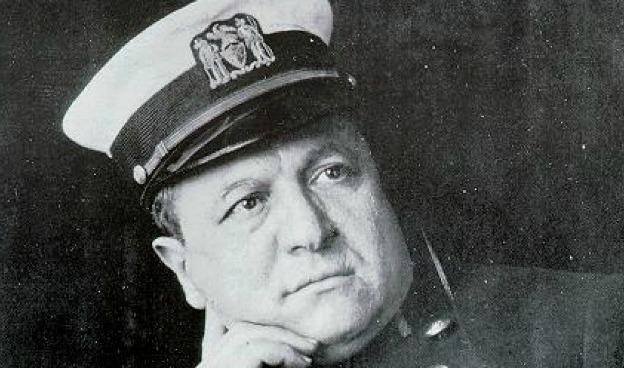For ITALY Magazine’s Italian-American series, we look at the legendary figure of Joe Petrosino, the Italian immigrant who became a police officer with the New York Police Department and is considered a pioneer in the fight against organized crime.
12 March 1909, 8:45 pm – New York City police officer Joe Petrosino stood in Palermo’s Piazza Marina, waiting to meet an informant supposed to give him information about the Mafia. No informant ever arrived. Instead, Petrosino was gunned down. Four shots. There ended the life and career of the Italian American who had made it his mission to fight and eradicate organized crime in the United States.
At his funerals in New York City a few days later, as many as 200,000 people were said to have shown up to pay their respects. Such was the admiration and appreciation for the work carried out by Giuseppe “Joe” Petrosino, a man who almost did not make it into the police department because he did not meet the height requirements.
Petrosino was born in Padula, in the southern Italian region of Campania, in 1860. He emigrated to the U.S. as a young boy and settled in New York City. Working as a shoe-shine boy outside of a police station, he is said to have developed a great admiration for his neighborhood cops.
He joined the NYPD in 1883, the first Italian native in the history of the department. He quickly distinguished himself for being hard-working and tough.
At the time, almost one quarter of New York City’s population was Italian. They tended to reside in Little Italy, which was poor, dirty, and overcrowded; daily life was difficult and distrust for the established authority common. It was fertile ground for organized crime to put down roots. In fact, several criminal organizations soon took control of Little Italy, especially the so-called Mano Nera (Black Hand), an extortion racket which, when demanding protection money from business owners, signed their threatening letters with the print of a black hand (or so the legend goes). The Black Hand expanded beyond New York to the Italian-American communities of major cities including Philadelphia, Chicago, New Orleans, San Francisco, and Detroit.
Early on in his career, Petrosino committed himself to fighting the Black Hand. He was especially angered toward these criminal figures who were ruining the hard-won good reputation Italian immigrants had built over the decades.
Petrosino had one asset the other police officers in the NYPD did not have: he could speak Italian. Criminals in Little Italy soon came to face an enemy who spoke their language, knew their methods, and could infiltrate into their milieu. His ability to solve crimes in the Italian community had him promoted to detective sergeant in charge of the department's Homicide Division in 1895. The promotion came from Theodore Roosevelt, who at the time was a police commissioner in New York and had become friends with Petrosino. Under Petrosino’s leadership, dozens of arrests were made, and crimes against Italian-Americans dropped sharply.

[Joe Petrosino is the first from the left.]
In 1908, Petrosino was promoted to lieutenant and placed in charge of the Italian Squad, an elite corps of Italian-American detectives created specifically to fight the criminal activities of organizations like the Mafia.
Petrosino understood the ties between the mafia in Sicily and the mafia in the U.S. and that the battle needed to be fought on both sides of the Atlantic. In 1909, he traveled to Sicily on what was to be a secret mission that would deal a blow to the Black Hand. A recently passed federal law allowed for the deportation of immigrants who had been in the country for less than three years if those immigrants had been convicted of a crime in another country. Petrosino knew of many Italian criminals who had moved to the U.S., and, on his trip to Sicily, intended to gather evidence of their criminal pasts so they could be deported. The mission however was leaked to the press by Theodore Bingham, Police Commissioner of New York.
Petrosino forged ahead as planned. On March 12, 1909, while waiting to meet someone who claimed to be an informant in Palermo’s Piazza Marina, he was ambushed and shot four times. The major suspect for the murder was Vito Cascio Ferro, a member of the Sicilian mafia who operated in the U.S. for a few years and who saw Petrosino as a threat to his criminal activities. However, Cascioferro provided an alibi for the night of the assassination. American authorities said at the time that the murder would never be solved.

In the summer of 2014, more than 100 years after Petrosino was murdered, Italian police seemed to have discovered who was the killer, following the arrest of 95 Mafia suspects in Palermo. Among them was Domenico Palazzotto, caught in police recordings claiming that the uncle of his father, Paolo Palazzotto, “committed the murder of the first police officer killed in Palermo, Joe Petrosino, on behalf of Cascio Ferro”. This would confirm the theory that Ferro was the mastermind behind the murder of Petrosino.
Petrosino was the first Italian-American police officer to die in the line of duty and the only New York City police officer ever killed in the line of duty on foreign soil. His legacy remains alive as the crime fighting techniques he pioneered during his legendary, albeit too short, career are still practiced by various agencies.












